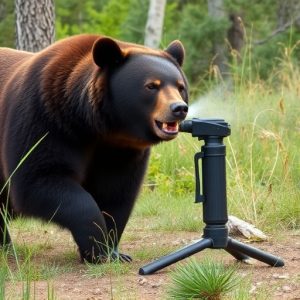Bear Country Hike Safety: Mastering Bear Spray & Beyond
Hiking safely in bear country requires understanding bear behavior, knowing feeding patterns, and ma…….
Hiking safely in bear country requires understanding bear behavior, knowing feeding patterns, and mastering the use of bear spray according to local safety guidelines. Regular practice sessions are crucial for effective deployment of bear spray, including checking expiration dates, inspecting packaging, and testing in controlled environments while wearing protective gear. A multi-layered safety approach includes familiarizing with deterrents, adhering to regulations, staying on trails, and consistently practicing bear spray testing, significantly minimizing risks during hikes.
Hiking in bear country requires more than just sturdy boots; it demands knowledge and proper equipment. Understanding bear behavior is your first line of defense, as awareness can prevent potential encounters from becoming dangerous. This article guides you through essential safety gear, focusing on bear spray—its effectiveness, testing, and optimal usage. We’ll also explore additional precautions beyond bear spray, ensuring you’re equipped with comprehensive hiking safety guidelines for navigating these wild environments.
- Understanding Bear Behavior: Knowing Your Potential Encounter
- Essential Equipment: Bear Spray and Its Effectiveness
- Safety Testing: How to Ensure Your Bear Spray is Reliable
- Proper Usage Techniques: Maximizing Protection During Hikes
- Additional Precautions: Beyond Bear Spray for Hiking Safety
Understanding Bear Behavior: Knowing Your Potential Encounter
Understanding bear behavior is a crucial aspect of hiking safety in bear country. Bears are generally shy and reclusive, preferring to avoid human contact. However, certain situations can trigger their protective instincts, leading to encounters that range from mildly unsettling to potentially dangerous. Knowing what might provoke a bear and understanding their feeding patterns can help hikers anticipate and navigate these interactions safely.
When venturing into bear country, it’s essential to familiarize yourself with the local safety guidelines, particularly those related to bear spray testing. Bear spray is a crucial defense tool against aggressive bears. Following the safety guidelines ensures its effectiveness; this includes proper usage techniques and understanding the recommended distances for application. Regular practice sessions can help hikers become more comfortable and confident in using this important piece of safety equipment during their outdoor adventures.
Essential Equipment: Bear Spray and Its Effectiveness
Bear spray has emerged as a crucial component of any hiker’s safety kit in bear country. It is designed to deter and repel bears when used correctly, offering a non-lethal means of self-defense during unexpected encounters. The effectiveness of bear spray lies in its ability to create a barrier between the user and the bear by releasing a potent stream of irritants that temporarily stun and disorient the animal.
When considering bear spray testing safety guidelines, it’s essential to note that proper usage is key. Users should practice the “spray pattern” technique, aiming for the bear’s face and eyes, as this has proven most effective in simulations. Regular maintenance and checking of expiration dates are vital, as bear spray can degrade over time. Following these safety measures ensures that hikers are well-prepared and equipped to navigate through bear country with increased confidence and protection.
Safety Testing: How to Ensure Your Bear Spray is Reliable
When it comes to bear spray testing, adhering to safety guidelines is paramount for hikers in bear country. The reliability of your bear spray is crucial for effective protection during encounters with these powerful animals. It’s essential to follow specific procedures to ensure its functionality when needed. Start by checking the expiration date and inspecting the packaging for any damage or signs of tampering.
Bear spray should be tested regularly, as per the manufacturer’s recommendations. This involves spraying it into a safe, controlled area mimicking the distance and angle of actual use. Ensure you wear protective gear, including gloves and eye protection, during the test to minimize potential risks. Check the spray pattern and distribution, making sure it reaches the intended target range. Verify that the nozzle is functioning correctly and that the canister remains intact under simulated pressure.
Proper Usage Techniques: Maximizing Protection During Hikes
When venturing into bear country, understanding proper usage techniques for your safety equipment is paramount. Bear spray, a common defense tool, should be tested and used according to established guidelines. Prioritize regular practice sessions to ensure effective deployment in an emergency. Learn the recommended distance, spray patterns, and post-encounter safety measures outlined by experts.
Proper handling involves checking expiration dates, inspecting for damage or leaks, and familiarizing yourself with the spray’s range and stoppers. During hikes, stay alert and follow safe trail practices to minimize potential encounters. Remember, knowledge and responsible usage of bear spray can significantly enhance your protection and enjoyment in these natural habitats.
Additional Precautions: Beyond Bear Spray for Hiking Safety
While bear spray is an essential tool for hiking in bear country, it’s just one component of a comprehensive safety strategy. Beyond carrying and knowing how to use bear spray, hikers should familiarize themselves with specific behaviors that can deter bears and minimize potential encounters. Understanding local regulations and staying within designated trails can significantly reduce risks. Regularly practicing bear spray testing according to the safety guidelines is crucial, ensuring its effectiveness when needed. Carrying a loud whistle can startle bears, allowing for an escape route if required. Wearing bright, reflective clothing increases visibility, potentially deterring bears curious about unusual appearances. Additionally, making noise while hiking in areas with known bear activity helps prevent surprise encounters, as bears are often cautious of unpredictable sounds.
When venturing into bear country, prioritizing safety should be your top priority. By understanding bear behavior and equipping yourself with reliable bear spray, you’re taking significant steps towards ensuring a secure hiking experience. Adhering to safety testing guidelines for your bear spray is paramount, as it guarantees its effectiveness when needed. Moreover, combining these measures with additional precautions can greatly reduce risks during your hikes in wild environments. Remember, knowledge and preparation are key to navigating bear country safely.


